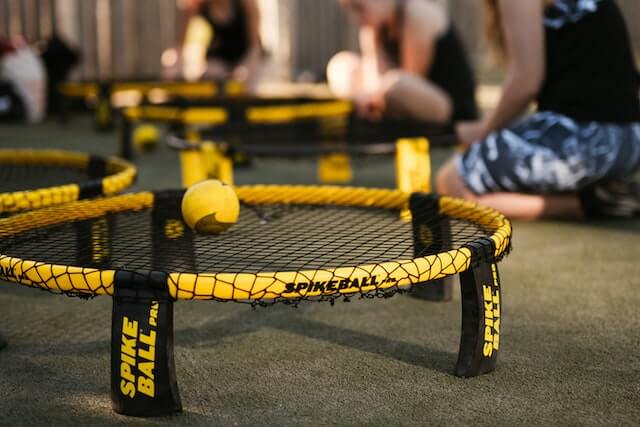A trampoline (also known as a rebound tumbling mat) is a low-impact physical activity that can be enjoyed by people of all ages. The first trampolines were created in the late 1800s from trapeze equipment and were used as training tools for acrobats. They were originally called “the Swiss gymnastics.” Springs were their jumping surface, but these proved to be dangerous because they could cause injury if someone fell on them. In 1948, George Nissen developed the idea of using canvas and padding to create a safer version of the trampoline which was patented in 1950.
The Trapeze: The Predecessor of the Trampoline.
While trampolines are known as a modern inventions, the history of their development goes back to Ancient Greece. The first trampoline was developed in the early 20th century and was called a trapeze, which is still used today. It is a gymnastic apparatus that consists of two ropes, one attached to each end of an upper bar, which serves as a springboard for a performer.
The performer performs acrobatic maneuvers while suspended in mid-air using the ropes attached to the bar. The device was invented in Hungary in the late 19th century and became popular throughout Europe in the early 20th century. The trapeze was originally used for acrobatics and gymnastics but evolved into a recreational sport in which participants were able to bounce up and down on a padded mat.
The First Trampolines.
The first trampolines were invented in the early 1900s by a German circus performer named Karl Schultze. His invention was known as the Trapeze, and it was a spring-loaded system of ropes and pulleys that allowed acrobats to perform aerial stunts without falling to the ground. The first recorded use of trampolines was in 1932 when they were used on a circus train. Soon after, they were used in home gyms and playgrounds.
In 1961, American gymnast Arthur Jones invented another type of trampoline, which he called the “air-track.” This new design was made from wood planks that formed a box shape around a spring-loaded netting surface. When people stood on this surface, they bounced up and down on it like they would if they were jumping onto a grassy basketball court or tennis court.
In 1968, U.S. Olympic competitions started using trampolines in their gymnastics events as well as other sports like diving and track and field events such as hurdles or long jumps. Today’s trampolines are made from high-quality materials such as plastic foam padding for comfort and safety features like rounded edges with no sharp edges or points for children’s safety.
Trampolines in the Olympics
In 2000, the trampoline became an Olympic event, with in-air acrobatics performed over a “bed” of springs. Trampolining is an acrobatic sport that requires flexibility and strength to execute difficult tricks on the ground or in the air. It also involves coordination between body parts so you can bounce around without getting hurt.
Trampolining originated as a children’s game in 1907 when Harry Houdini performed his famous “trampoline escape” stunt at Madison Square Garden in New York City—a feat that was later filmed by Edison Studios and made into an early silent film called “Daredevil of Paris.”
Trampoline Games
Trampolining games are the best way to spend time with your friends. There are many ways to play these games, but they all have one thing in common: they’re fun! You can play them with just one person, or you can get a whole group together. some of the best trampolining games include:
- Trampoline Dodgeball
- Trampoline Soccer
Trampolining is a sport that combines elements of gymnastics and acrobatics, in which participants jump off a trampoline and propel themselves into the air. The game of trampolining is played with two teams or individuals on two opposite sides of a trampoline. One person is designated as the “jumper” and stands at the end of the trampoline, facing away from the other players. The other players stand on either side of the jumper, facing away from him.
Benefits of trampolining
The benefits of trampolines are numerous, and they can be enjoyed by both children and adults. Here are some of the most common trampoline benefits:
- Improved cardiovascular health
- Better muscle strength and flexibility
- Improved mental health (including reduced stress and anxiety)
- Improved bone health (Trampolines help improve bone density in the long term, which can reduce the risk of osteoporosis later in life.)
Trampoline safety
Trampolines are fun, and they can be used to help you get in shape. But you need to be careful when using it. Here are a few things to keep in mind when using one:
- Trampoline safety tips
- How to set up a trampoline safely
- What sort of equipment do you need for your trampoline
Trampoline safety is important. The biggest risk of trampolines is spinal cord injury, which can be fatal. The number of trampoline injuries varies from year to year, but the risk of injury is highest during the first year a trampoline is in use and after major trampoline renovations. If you are concerned about your own or your child’s safety on a trampoline, it is best to get a professional opinion on whether or not they should use one.
Trampolines are some of the most fun things you can do outside with your kids, but they can also be dangerous. Here are some tips on how to be safe while on a trampoline:
- Always double-check the safety requirements when buying a trampoline. Make sure that it has an enclosure and is safe for children under age 14.
- Never allow young children to jump onto a trampoline alone; always have at least one adult nearby.
- Check your trampoline regularly especially after heavy rains or storms to make sure that everything is still working properly.
If you’re thinking about buying a trampoline for your child, these are things you should know.
- First and foremost, don’t let your child jump on the trampoline without supervision. This is especially important if the trampoline is being used in an area where some older children or adults may be around.
- make sure that your child doesn’t bounce or jump on the trampoline in a way that could get them to hit.
- Make sure that your child wears proper safety gear when they use the trampoline: helmets, knee pads, and elbow pads are all good choices.
- make sure that they know how to stop themselves from falling off and landing on their heads if they do fall off!
- If you’re worried about your child falling off of the trampoline, make sure they stay within arm’s reach of you. If they need help getting back up, reach out and grab them!
We have written a detailed safety guide on trampoline. you can find here.
The future of trampolining
The future of trampolining is bright! Trampolines have been around for decades, but they are still being used in the present day. This has led many people to wonder what the future holds for trampolining. The answer is that trampolining will continue to grow and evolve over the coming years. The best way to ensure that this happens is by staying informed about how the industry is changing and what new developments are happening around it.
FAQs
Question: Can I use my trampoline at home?
Answer: Yes, you can use your trampoline at home. You should always take safety precautions when using your trampoline at home, but it is possible to do so!
Question: How long does it take for my trampoline to break in?
Answer: It depends on how often you use the trampoline and how much force you put on its frame. The more often you use it, the faster it will break in.
Question: Is there a warranty on my trampoline?
Answer: Yes, there is a limited warranty on all of our products. We will replace any part that fails during normal use within one year of purchase.
Conclusion
So there you have it: the history of trampolines, from trapeze artists to modern trampoline parks. We are still trying to figure out how to combine gymnastics and acrobatics into an exciting new sport that makes everyone feel good, but we’re making progress!

